|
|
|
|
|
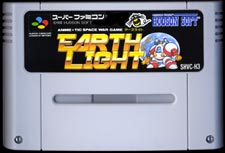 |
|
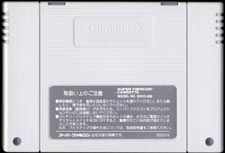 |
|
|
|
|
| Title: |
Earth Light |
Release Date: |
07.24.1992 |
|
System: |
Super Famicom
(Nintendo) |
Release Price: |
8500
yen ($77 USD) |
|
Format: |
Cartridge |
Note: |
Is the release price correct? If so, |
|
Country: |
Japan |
|
why was Earth Light so expensive? |
| |
|
|
|
|
Developer: |
Hudson Soft |
Genre: |
Turn-based war
strategy (simulation) |
|
Publisher: |
Hudson Soft |
# of Players: |
1 |
|
Catalog #: |
SHVC-H3 |
|
|
| |
|
|
|
|
|
|
|
|
| |
introduction &
background information: |
TOP
|
Upon its release in
1992, Earth Light
was a bit of a novelty in the realm of turn-based war
strategy games. In Earth Light, the entire arsenal of weapons
and troops at your disposal were decidedly "cute" and cartoon-like in appearance
(fittingly adorned, I should add, in wardrobes of powder-blue,
canary-yellow, hot-pink, lime-green, and sugarplum-purple).
Yes, Earth Light featured purple space cruisers, pink
artillery cannons, and lime-green MECHs. This unabashedly
cheerful approach to war gaming contrasts sharply with the more
"serious", "somber", "gritty" and oftentimes
clinical atmosphere commonly found in today's (and
yesteryear's) war simulations. Earth Light is
cute, through and through (except for the just plain goofy antagonist who
stars in the cinema screens . . . dig the irony of the peace medallion
he's wearing?).
|
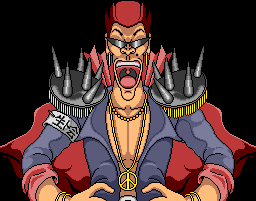 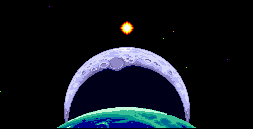
|
I love all the character designs in Earth Light -- except for this one, of course. Why is this clown even in the game? He clashes with the look & feel of the entire game. His presence detracts from the cinema scenes and the cover art. This goofball is not even worthy of Data East's BAD DUDES, is he?
|
Now, I am not suggesting that Earth Light pioneered a brand-new
genre in gaming (i.e. "cute-war-gaming") ... but the fact
remains that I have
yet to identify a precursor to
Earth Light's cheerful, cartoon-like aesthetics. So
maybe I am claiming that the look and feel of Earth Light was
innovative and creative. [NOTE: If you can
help clear this up, please contact
me ! I am by no means an authority on this subject. Thanks! ] So, let me clarify my thoughts: strategy war
games prior to Earth Light have had cute elements in them (i.e.
cute character designs), but was there a strategy game prior to Earth Light
that was so entirely steeped in cuteness? My best guess is that there were some "SD"
strategy games -- as in,
"Super Deformed" -- that paved the way for Earth
Light... (one possible contender is the SD GUNDAM series that began
| PRETTY IN
PINK : The arsenal of weapons featured in EARTH LIGHT looks like
something you'd encounter in an alternate universe, a universe where
MACROSS and BARBIE have fused together in eternal bliss. Even the
names are cute as hell. This should be a toyline, no joke. I'd love
it. |
on Nintendo's
Famicom, but I have yet to play any of these games). Regardless,
you get the point: Earth Light's entire universe is a
pastel lollipop and the space armadas populating them are chewy
gumdrops. Now, I've made a lot of fuss about the appearance of Earth
Light and the difficulty in naming its aesthetic
predecessor. In
other words, I devoted a lot of time and energy to one of the least important elements
of a video game (i.e. graphics). I am thoroughly ashamed for being so damn
shallow in my discussion thus far... let's move on, shall we?
|
| |
digging deeper:
earth light's predecessor |
TOP
|
When we shift our attention away from
aesthetic superficialities and focus instead on the real meat of the game
-- such as the battle system, the A.I. of your computer opponent, the play
mechanics, the overall flow of gameplay, etc. -- we have a much
easier time identifying Earth Light's
lineage. Earth Light is a direct descendent of another Hudson Soft strategy game:
Nectaris (1989 PC-Engine, Japan). Nectaris was
released in North America as Military Madness for the little-known
|
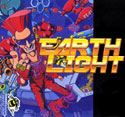 |
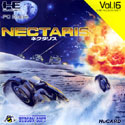
 |
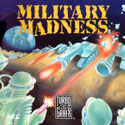
 |
|
|
Earth
Light ( 1992, Japan )
Super Famicom Cartridge |
Nectaris
( 1989, Japan )
PC-Engine HuCard |
Military
Madness ( 1989, N. America )
TurboGrafx-16 HuCard |
|
TurboGrafx-16 video game
console (TG-16 was the North American version of the Japanese
PC-Engine). Now, Earth Light is not a direct sequel to
Nectaris, but
the similarities between the two games are quite strong.
Essentially, Earth
Light borrows all the major components of its predecessor and slightly
reworks them: (1) the core battle system remains intact (sharing
a similar formula that rewards strategies that surround opponents, provide
support for your troops and exploit the effects of the terrain), but it has been expanded to include
hand-to-hand combat as well as secondary weapons; (2) weapon
classes, and their functions, parallel one another (i.e. both games have troop
carriers for swiftly transporting slow-moving units, infantry are the only
means of capturing factories (or, space docks, in the case of Earth Light),
(3) the battle scenes follow the same format, (4) the user-interface, menu system
and commands are nearly
|
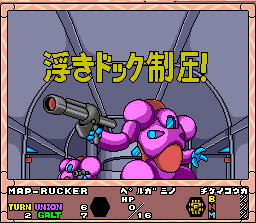
|
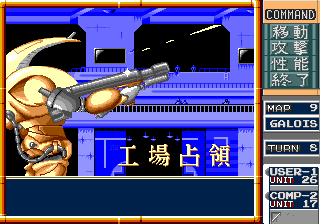
|
|
Space Dock
Captured! ( Earth Light 1992 ) |
Factory Captured!
( Nectaris 1989 ) |
identical, etc. Taking
stock of these common features, it
should come as
no surprise to
discover that both games were written by the same programmer at Hudson Soft.
[ Source: Lee Pappas' Nectaris
Page ] ASIDE: Lee Pappas was perhaps the first person -- on
an English- language website -- to discuss Earth
Light's relationship to the the Nectaris series. He is a fellow Nectaris fanatic and his long-defunct Nectaris fansite
inspired me to create BASE NECTARIS many moons ago.
Space docks -- like the factories of Nectaris -- play a crucial role
in the strategy of Earth Light: they are the only
reliable means of acquiring additional troops and the only means of
repairing damaged troops. However, the space docks of Earth
Light cannot be "captured" as easily as the factories of
Nectaris, since the space docks have defenses and hit points.
Nectaris players will have to re-think their old strategies when
playing Earth Light, since the "rush-in-the-infantry- with-no-support" method won't work too
well when trying to seize space docks (or enemy headquarters, for that
matter).
|
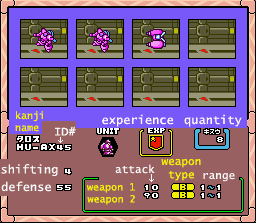
|
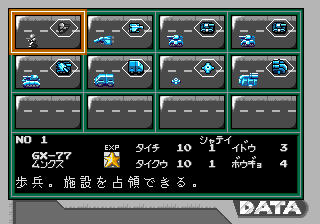
|
|
Space Dock Inventory
Screen (Earth Light 1992) |
Factory Inventory
Screen (Nectaris 1989) |
Earth Light's gameplay is reminiscent of
Nectaris and will appeal to aficionados
of old-skool turn-based strategy games. The battle system of Earth Light is more
varied than its predecessor, however, and thus it takes a bit of time before
you really hone your strategies and tactics. For example, nearly all weapons have at
least two modes of attack (after some trial-and-error you will discover which
weapons work best with particular opponents), the effects of terrain
are not as intuitive and straightforward as Nectaris (I'm still trying to
figure everything out), factories and enemy strongholds cannot
simply be "captured" ( they have defenses and hit points and must be defeated in battle first),
etc.
Nectaris was set in the gritty, muddy, confined & repetitive
battlefields of the Moon, whereas Earth Light offers vast and varied
settings by taking the battles
into space. Earth Light goes a step further by adding a neo-medieval twist to the gameplay (i.e. MECHs are armed with both swords
and guns; enemy strongholds resemble hi-tech "castles", etc.). The hand-to-hand melees,
by the way, are an interesting extension of the Nectaris battle system --
it's fun to see an old-skool
|

|
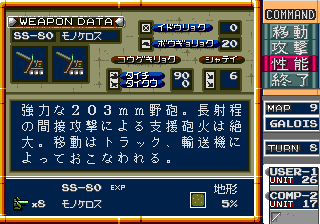
|
|
Weapon
Guide ( Earth Light 1992 ) |
Weapon
Guide ( Nectaris 1989 ) |
sword-wielding MECH like Talus rip hi-tech, gun-laden
opponents to shreds. Or should I say, I wish it were fun.
Unfortun- ately, the battle scenes are anti-climatic and
unsatisfying. Whereas Nectaris provided some genuine satisfaction when
you blew up your opponent's troops, Earth Light falls short
viscerally. As a result, the battle scenes in Earth Light come across
as merely perfunctory and do not add to drama of the ongoing
battle. In fact, overall, I would say that Earth Light is less
alluring and not nearly as addictive as the Nectaris series. Earth
Light is certainly worth checking out if you are a Nectaris fan, but I
suspect that Earth Light's charm only reveals itself after investing some
time in it (unlike Nectaris, which I found instantly addicting). For
example, in some later levels, Earth Light mixes things up by having armadas
of new ships arrive at the frontlines a few turns after play has
begun. This would have been a wonderful feature to incorporate into
the Nectaris sequels, I think, because it opens up the game universe
somewhat: Nectaris was always a tightly closed system -- the number of
troops available always clearly defined at the onset of a stage.
At least Earth Light experimented with the old formula...
FINAL THOUGHTS & QUERIES : It doesn't appear as if Earth
Light was particularly popular in Japan... although Lee Pappas
states that this Super Famicom title was a limited release from Hudson
Soft. And so we are left with a bunch of questions: Did Hudson candy-coat Earth Light in an
effort to be "innovative" and make it appear more
distinctive and unique than the typical strategy game of the
day? Or was Hudson attempting to broaden the appeal of Earth
Light by making it palatable to gamers who weren't typically
interested in the strategy genre? Or was it something else
entirely? For example, perhaps Earth Light was Hudson's attempt to
develop an SD Nectaris of sorts? Yeah, I know that is
stretching things, but here is the biggest puzzler of them all:
Hudson Soft recycles and rehashes its popular series ad nauseum (this
fact has permanently stunted the growth of the Nectaris series), so
why didn't they try to make another Earth Light a la Nectaris?
Why, oh why, did they give us . . .
|
|
Earth Light II: Luna Strike
(1996, Japan, Super Famicom). Developed and published by Hudson Soft (SHVC-AE5J)
Luna Strike shares little, if anything, with the original Earth Light.
From the core game engine and play mechanics, to the aesthetics and gameplay
-- the two games are different. For more information on the sequel
to Earth Light, check
out the embryonic Luna Strike FAQ featured at here at
BASE NECTARIS. Hey, at least it's something!
Essentially, Earth Light is a reworking of the Nectaris game
engine. As a
result, Earth Light is similar to the entire series of Nectaris
/ Military Madness games (released during 1989-2004 for numerous platforms in Japan, Germany, & North America).
If you are short on time (or patience), then you will want to consult the Quick List
of All Nectaris Games. Otherwise, I encourage you to dig into the
more detailed Nectaris
Legacy.
|
|